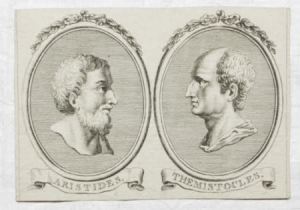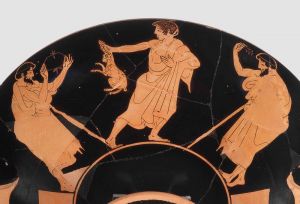(Boylove Documentary Sourcebook) - The Origin of the Rivalry between Aristides and Themistocles in Their Pederastic Competition for Stesilaus, a Young Male Beloved, According to Ariston of Ceos, as Stated in 'Aristides' by Plutarch: Difference between revisions
(Added the page to the "Historical literature" category) |
(Added a missing bracket to the reference of the excerpt) |
||
| Line 2: | Line 2: | ||
From <i>Aristides</i> (Ancient Greek: Ἀριστείδης <i>Aristeídēs</i>, Latin: <i>Vita Aristidis</i>), Chapter 2, in <i>Lives</i> (Ancient Greek: Βίοι Παράλληλοι <i>Bíoi Parállēloi</i>; Latin: <i>Vitae Parallelae</i> [Early 2nd Century AD), by [[Plutarch]], translated by Bernadotte Perrin, Volume 2, <i>Loeb Classical Library</i> (London: William Heinemann; Cambridge, Massachusetts: Harvard University Press, 1914). Footnotes omitted. | From <i>Aristides</i> (Ancient Greek: Ἀριστείδης <i>Aristeídēs</i>, Latin: <i>Vita Aristidis</i>), Chapter 2, in <i>Lives</i> (Ancient Greek: Βίοι Παράλληλοι <i>Bíoi Parállēloi</i>; Latin: <i>Vitae Parallelae</i> [Early 2nd Century AD]), by [[Plutarch]], translated by Bernadotte Perrin, Volume 2, <i>Loeb Classical Library</i> (London: William Heinemann; Cambridge, Massachusetts: Harvard University Press, 1914). Footnotes omitted. | ||
<div style="margin:.5em auto; width:95%; min-height:5em; background-color:#F5FAFF; border:3px solid #c9c9ff; padding:1em;"> | <div style="margin:.5em auto; width:95%; min-height:5em; background-color:#F5FAFF; border:3px solid #c9c9ff; padding:1em;"> | ||
Latest revision as of 02:06, 25 September 2021

From Aristides (Ancient Greek: Ἀριστείδης Aristeídēs, Latin: Vita Aristidis), Chapter 2, in Lives (Ancient Greek: Βίοι Παράλληλοι Bíoi Parállēloi; Latin: Vitae Parallelae [Early 2nd Century AD]), by Plutarch, translated by Bernadotte Perrin, Volume 2, Loeb Classical Library (London: William Heinemann; Cambridge, Massachusetts: Harvard University Press, 1914). Footnotes omitted.
But Ariston of Ceos says that this enmity of theirs, which came to be so intense, had its origin in a love affair. They were both enamored of Stesilaus, who was of Ceian birth, and in beauty of person the most brilliant of youths; and they cherished their passion so immoderately, that not even after the boy's beauty had faded did they lay aside their rivalry, but, as though they had merely taken preliminary practice and exercise in that, they presently engaged in matters of state also with passionate heat and opposing desires.

See also
- Adult friend (dictionary)
- Age of attraction (dictionary)
- Athenian pederasty
- Boylove
- Ephebophilia
- Erastes
- Eromenos
- Greek love
- Historical boylove relationships in ancient Greece
- Loved boy (dictionary)
- Minor-attracted person (dictionary)
- Pedophilia
- Philosophy of ancient Greek pederasty
- Spartan pederasty
- Theban pederasty
- Young friend (dictionary)